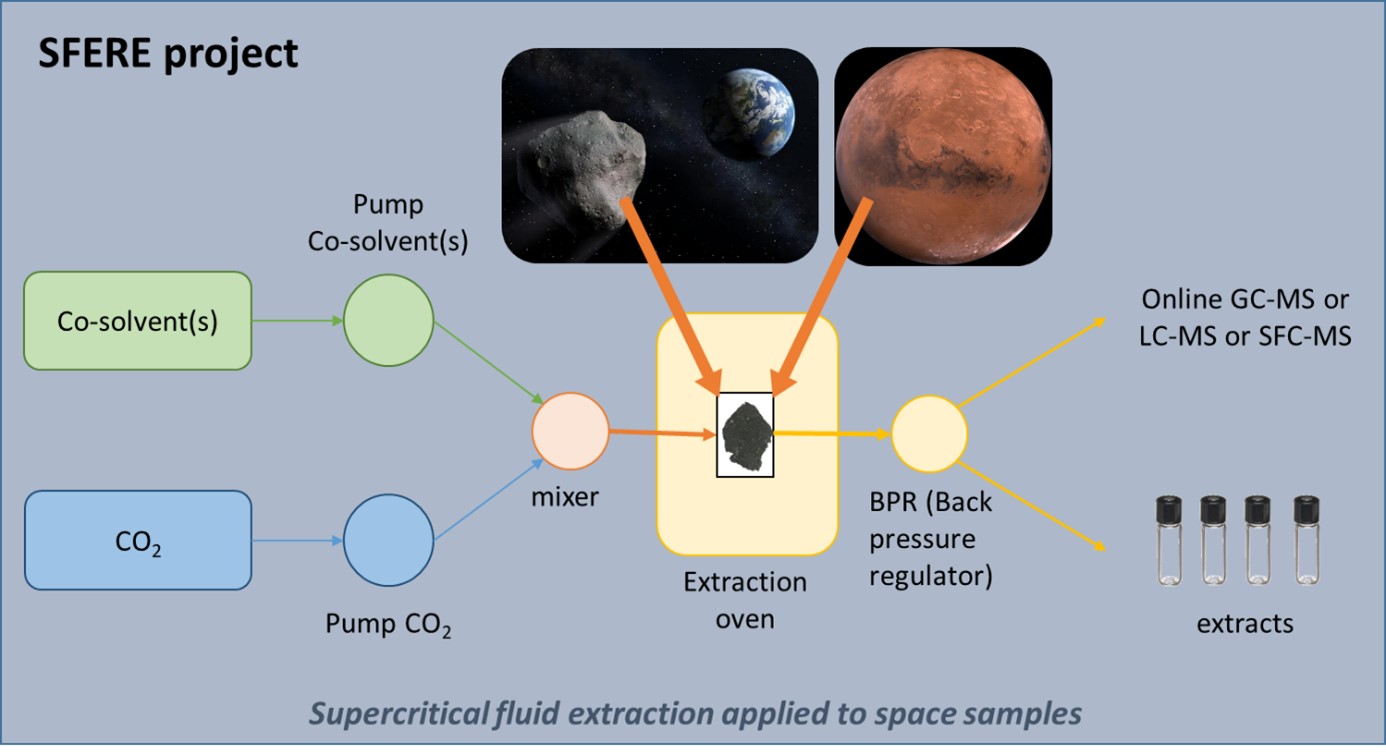SFERE
SFERE Project: Development of SFE for sample return

Contact LISA : C. Azemard (This email address is being protected from spambots. You need JavaScript enabled to view it. This email address is being protected from spambots. You need JavaScript enabled to view it. )
The analysis of extraterrestrial organic matter is crucial to understanding the appearance of life in the universe. While prebiotic chemistry gives us clues to the appearance of life from the building blocks of living organisms, many of the stages in the appearance of complex molecules have yet to be determined. To achieve this, all the analytical stages or "technological building blocks" need to be optimized: extraction, trapping, separation and identification. However, the first step in this process, the extraction of organic matter from the various extraterrestrial matrices, is a limiting one. Currently, in the laboratory, liquid-solid extraction techniques (ultrasound, Soxhlet), which are often lengthy or involve several stages, are used for the most part, despite the risks of contamination. In-situ, the situation is even worse, since thermal desorption is the only method that can be used in space, a method whose yield remains well below that of other techniques. This is the background to the SFERE project, aimed at developing supercritical fluid extraction of extraterrestrial organic matter. The other technological building blocks are being developed in parallel by the team and other French and international laboratories, depending on the expertise required.
SFE is a technique that dates back to the 50's, using mainly supercritical CO2 to extract apolar molecules from various matrices. However, the target molecules in exobiology are often polar, and this lack of versatility certainly explains why SFE has been little used in the space sector until now. Recently, thanks to a strong analytical development, this device can use co-solvents allowing the extraction of a wide range of molecular families, making this technique much more interesting for our field. Switching to the supercritical state gives us the advantages of both gases and liquids, as diffusivity and viscosity can be adjusted by controlling the temperature and pressure of the fluids. The literature shows equivalent or better yields than conventional techniques, while reducing the risk of contamination during sample handling. The key is to optimize the numerous variables (temperature, pressure, co-solvents, etc.) according to the matrices of interest. We are primarily interested in the extraction of meteoritic organic matter, and to this end have recovered several samples thanks to national and international collaborations developed within the team. The optimization of parameters for Martian soil analogues is also important in order to position ourselves for the return of Martian samples by the Mars Sample Return (MSR) mission, scheduled for the mid-30s. The extracted material can be recovered for analysis using a variety of techniques within our own laboratory, but also in collaboration with others to gain access to high-resolution mass spectrometry, for example. The device is also coupled to supercritical chromatography (SFC), a recent development that enables the use of columns similar to those used in liquid chromatography. The final coupling with a mass spectrometer (MS) enables the extracted material to be analyzed on-line. SFE-SFC-MS therefore requires no human intervention after sample introduction, greatly limiting any risk of contamination on the analytical chain.
In the short term, the use of this technique should make it possible to improve extraction yields and, consequently, laboratory analysis of extraterrestrial objects, while limiting the risk of contamination. In a context of increasing numbers of sample-return missions (Osiris Rex in 2023, MSR mid-2030 and Moon Mars eXploration planned for 2029), such expertise would place the laboratory at the cutting edge of extraterrestrial sample extraction technology. In the long term, the spatialization of this technique should be envisaged for in-situ analyses. The laboratory's technical department already boasts considerable expertise in the development and manufacture of space devices.
This project is currently getting off the ground, having received support from the Origins PEPR, the Origins DIM and a JCJC ANR in 2002 and 2023. The grants will enable the purchase of an SFE-SFC-MS and a sample collector in 2024, as well as the hiring of an IR for 1.5 years and a thesis, both starting in autumn 2024. As this technique is currently relatively undeveloped, it will give LISA a technological edge. What's more, this device will also be accessible to other agents in the public and private sectors, as it will be integrated into the PRAMMICS analytical platform. Several collaborations have already been developed as part of the SFERE project, in particular with IC2MP (Poitiers), PIIM (Marseille) and IMPMC (Paris).


